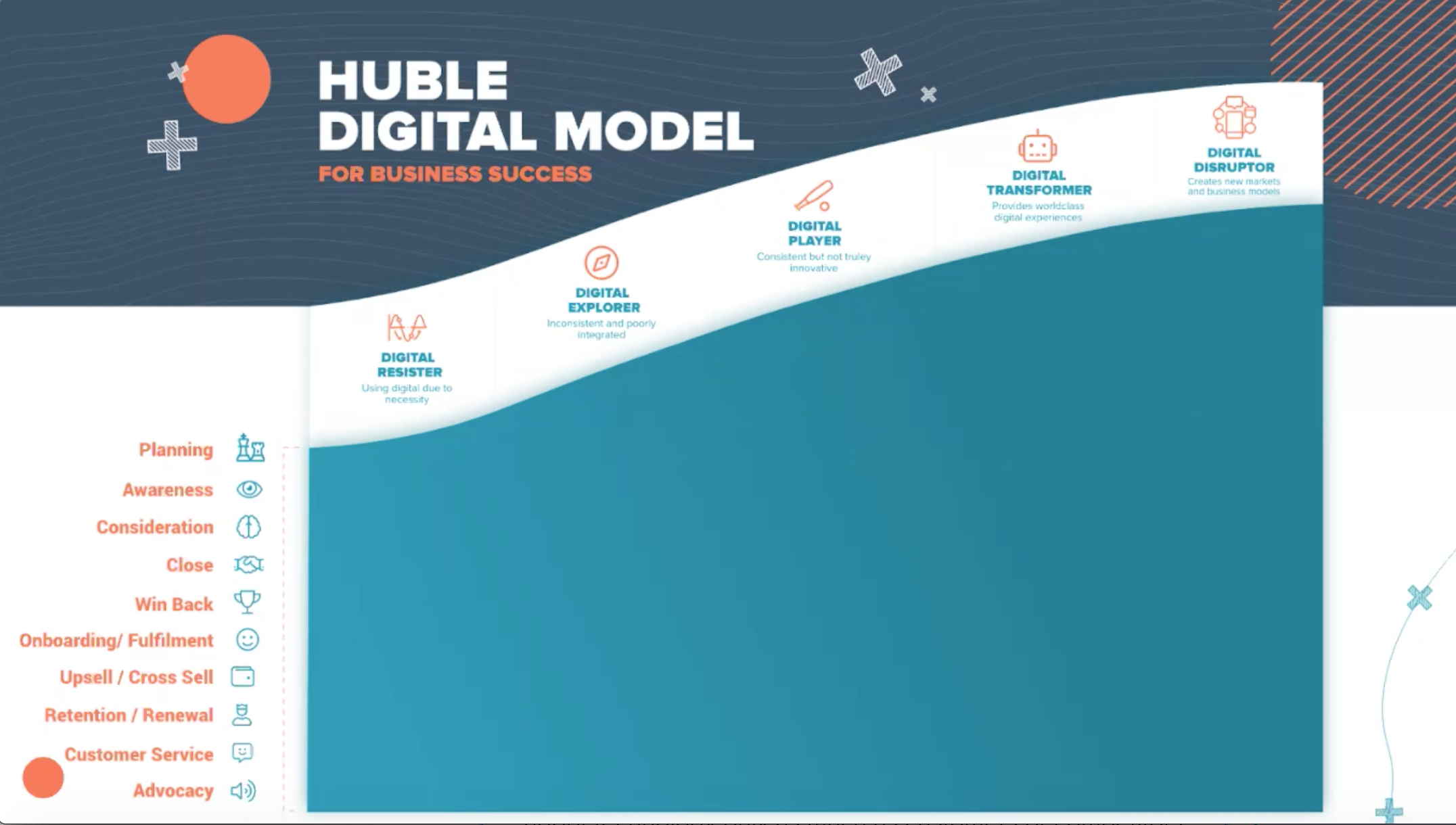What does it mean to be digitally mature? In this blog post, we look at our Digital Maturity Model, launched at Grow with Inbound this year, and discuss how you can use it to scale your business with educated business decisions.
“Digital maturity” is fast becoming a buzzword, as technology plays an increasingly important role in business processes and customers choose companies with a digital presence. But what does the term actually mean and, more importantly, why should businesses care about their digital maturity?
Our Chief Strategy Officer, Daryn Smith, launched Huble Digital’s digital maturity model at our 2020 Grow with Inbound event as an answer to that question. It’s a guideline for anyone wanting to create meaningful growth in their business and surf the wave of an increasingly digital society and economy. Here are 5 tips to help unpack this tool:
The Huble Digital Maturity Model
Digital maturity is about more than just using technology in your marketing. The Huble Digital model looks at how well you use technology across your organisation, and at every customer touchpoint, to ensure frictionless and delightful customer experiences.

At every stage of the customer life cycle (the Y-axis in the image above) your organisation will be at one of the following stages of digital maturity (the X-axis):
-
Digital Resistor. You’re digital because you have to be, and you adopt technology only as much as customers or competitors are forcing it on you.
-
Digital Explorer. You’re exploring digital, and your engagement with technology is often project-driven. This often means technology is poorly integrated into your products and processes and can make the customer experience inconsistent.
-
Digital Player. The majority of companies are digital players — providing consistent CX with the help of technology across their processes, but they’re not truly innovative.
-
Digital Transformer. ‘Digital transformation is a popular goal for many companies. At this stage of digital maturity, you’re able to deliver consistent, world-class digital-first experiences.
-
Digital Disruptor. You’re using digital to create new markets and business models.
Dive into the details of what each stage of maturity means for each stage of the customer lifecycle with Daryn in his Grow with Inbound 2020 talk, How Digitally Mature Is Your Company?.
Digital maturity isn’t a one-size-fits-all
Digital maturity means something different for each company. Your ideal matrix of digital maturation across the customer lifecycle, and at each touchpoint, will be unique to your company, your target market, and your goals. For example, your ideal may be to become a digital transformer during the Customer Service stage, offering consistent, world-class digital-first experiences and solutions to customers who need help. Meanwhile, you may enjoy the freedom to be a digital explorer at the early planning stage, as your team works best with the freedom to experiment with different technologies as they plan winning strategies for different projects.
In his Grow With Inbound talk, Daryn shared the following definition of maturity as “beginning when you’re content to feel right about something, without feeling the need to prove someone else wrong.” So, what’s right for your company? Whatever your blend of digital maturity looks like, is essential to identify which stage you’re at (across different departments, or customer life cycle stages) if you want to remain competitive.
Know why you’re benchmarking your organisation
What’s the purpose of assessing your digital maturity? If you know where you are today and can identify where you want — or need — to be in the long term, you’re one step closer to achieving business resilience. With customers now expecting digital-first experiences, and top talent prioritising the flexibility of remote work (not to mention the unexpected necessity of these during the pandemic), being aware of your current digital maturity is no longer an option; it’s a part of the process that gets you where you need to be to succeed.
You can’t skip steps, but you can go backwards
You have to start somewhere on the digital maturity scale, and you can’t skip steps. So, if you’re currently a digital explorer, you’ll need to become a digital player and digital transformer before you have the experience, infrastructure and resources to become a digital disruptor.
Unless you work on it constantly and take pains to push the boundaries of each stage, you can and will slide backwards in maturity. Clinging to what sets your company apart as a transformer now, may very well be what defines you as a digital resistor in a decade (or less!).
Disruptors disrupt on customer experience, not technology
Being digital, or having a kick-ass digital marketing team (and the budget to match) doesn’t make you a disruptor. While there are even a few formidable digital-first organisations, they’re not necessarily digital disruptors. These disrupt customer experience (not technology and not just for marketing) and use digital to scale across the whole customer life cycle.
How Huble Digital can help
Businesses are similar to people in many ways. Like individuals, their maturity changes depending on who they’re with. So, the first step to achieving your digital maturity is to surround yourself with the right people. Ask yourself:
-
Who do you need in your organisation to achieve your desired maturity?
-
Are the existing team’s skill-sets still relevant?
-
Will the existing team be able to help you mature?
Download our full digital maturity model to help you answer these questions. Using the worksheet, you’ll be able to identify exactly where in your customer life cycle you need to kickstart digital maturation. Then, send your worksheet in for our team to review. We’ll provide feedback and advice on how you can best grow your maturity in the digital space. Click the button below and get started!
Download the Full Model








.png)





